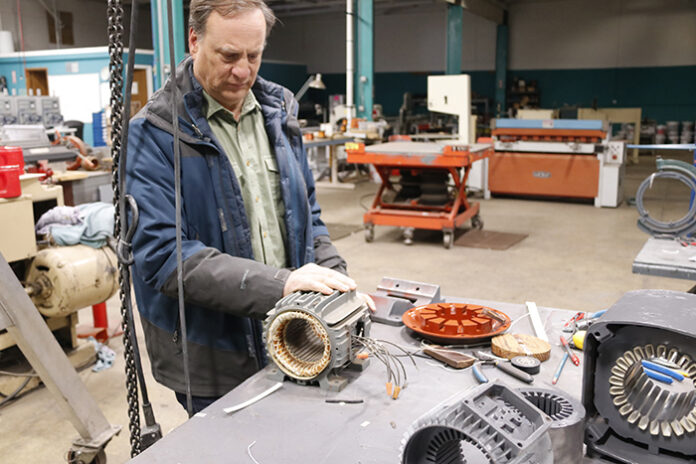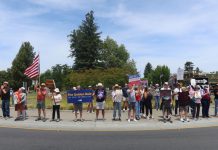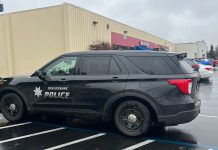
There are many signs of change afoot in Healdsburg, from new restaurants under development, favorite espresso shops reappearing and multi-unit housing projects sprouting on the edges of town.
But some changes are less visible, though ultimately more significant. E&M, a 67-year-old motor repair shop, is leaving behind the business that gave it an honored place in Healdsburg history to focus instead on an increasingly successful business sector—industrial automation sales and services.
Given their trade, anyone would be forgiven for thinking that E&M stood for Electric and Machine, or some variation. In fact, the initials are those of founders Edgar Deas and his father, Mario, who in 1955 started with a small motor shop on Healdsburg Avenue, just south of the Plaza.
A few years later, they moved around the corner to 12 Matheson, where they had a service garage next to Fred Young Mortuary (where now stands The Wurst). Later still, about 1983, they left the Plaza area and took over a warehouse at the corner of Mill and East streets. It was formerly a produce-packing facility for Sunsweet, known for its prunes when Healdsburg was celebrated as “the buckle of the prune belt.”
Mario Deas is gone now, and his son, Edgar, is 86 and no longer active in the business he co-founded as a young man. His own sons, Paul and Steve, now run the company and are looking to the future for E&M. Despite the collapse of the motor repair trade, about which more later, their future is in the related field of industrial automation. That’s a growing field, and E&M currently employs 120 sales and service workers, with offices in southern California, Oregon and Washington, as it maintains headquarters in Healdsburg.
“It’s an honor to continue to grow the business my parents and grandparents built from scratch,” said Paul Deas, Edgar’s son and the company’s chief financial officer. “What started with a small motor shop has evolved into a modern industrial automation company. We won’t be repairing motors anymore, but we still sell motors and their associated control equipment, building on the knowledge that we have gained over the decades.”
Paul Deas’ brother, Steve, is the company’s chief executive; both have worked full time for the business since the 1980s. Several of their children also work for E&M now, making them the fourth generation of Deases to have rolled up their sleeves in the motor shop at one time or another.
It was Mario Deas’ deep understanding of the inner workings of motors that brought him and his family from Cuba to the United States during World War II. He had worked on the development of a machine that processed tailings from mines to extract additional ore, and was recruited to work in Nevada in 1943. After the war, he and his son found work servicing motors in the Bay Area, eventually landing in Healdsburg.
Here, their main customers were at first lumber mills, which had the benefit of using machinery that needed repair, and often. “It’s a really harsh environment, lots of sawdust,” said Steve Deas. “It was a continuous battle to keep the motors running.” That meant lots of work, and when the lumber mills slowed their work, the growing wineries stepped up with their own needs for repair.
Contrary to expectation, motor repair need not have anything to do with automobiles. Those are driven by engines, not motors: Engines run on internal combustion, but motors run on electricity. “There are several motors in homes—washing machines and dishwashers have pumps. The biggest motor in your house right now is probably your air conditioner,” said Paul Deas, referring to its compressors, pumps and fans.
E&M originally would even repair hand tools—a skill saw, for instance. “Most of the hand tools that I tried to repair never worked again,” deadpanned Paul Deas. There’s an art, or at least a very specific set of skills, to winding a motor with new copper wire so it will generate energy. Their shop where Mill Street meets East—behind the office building that houses not only their offices but art studios and other businesses—is littered with the shells of non-working motors, ranging in size from small enough to lift to far too heavy to pick up without a winch.
“The problem is over the years these things get more disposable, and the size of the motor that we could repair economically started to increase,” said Steve Deas. For a while, they repaired motors up to five horse power, then 10; now even those rarely come in for repair. “The problem is we live in an area that doesn’t have a lot of industry. Now it’s only profitable to repair a motor that generates over 100 horsepower.”
Now too many people are willing to just throw them away—and why not? It costs more to repair it than buy a new one, at least to a point (a power drill or Skilsaw, for instance)… but what happens to other larger motors needing repair?
“They will be repaired, but it will happen someplace other than here,” said Steve Deas firmly. “Vallejo, Sacramento, Oakland, San Leandro, someplace in the peninsula… That’s somebody else’s problem.”
“When you look at the industry we do have now, like the wine industry, the only thing they have to repair are refrigeration units,” said Paul Deas. “A smaller winery has 50-horsepower motors; a larger winery—like the ones Gallo has around here—they might have 500-horsepower refrigeration equipment. But there’s four of them.
“The truth is a well-maintained motor will run 20-30 years, so it’s not like they’re failing every day,” he continued. “Now we have a situation where they rarely need repair. The materials have improved and the industries around here have changed so they aren’t as hard on motors any more.”
The E&M motor shop currently has six staff members. All of them are expected to work through the end of the year. Some will stay on to help wind down operations, and some will move to other divisions within the company. Increasingly, that means not motors, but automation.
In a large clean room near the atrium (a secret location hidden in the main office), a gangly blue machine bolted to a table (and wearing a Santa hat) pivots and waves its single articulated arm to stack Jenga blocks in a demonstration of programmed automation. It’s powered by a servo motor, but the programming’s the thing—and E&M is pivoting to industrial automation.
“Last year, the motor shop did $1 million in business. But overall, we did $67 million—the rest of that is selling industrial automation components and services,” said Paul Deas.
“This has been pretty hard for our father, who is sad to see this go but understands it,” Steve Deas interjected. That would be Edgar Deas, the E of E&M. “We tried to emphasize to him it’s everything we have, every other part of the business is because of that motor shop… They didn’t just repair motors, they built control systems for lumber mills to feed logs through into saws. They were really good at this kind of stuff, and that’s what built the business.”








